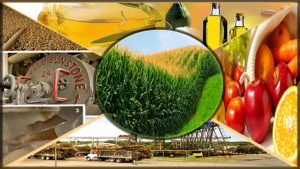 The active soil forming factors are those which supply energy that acts on the mass for the purpose of soil formation. These factors are climate and vegetation (biosphere).
The active soil forming factors are those which supply energy that acts on the mass for the purpose of soil formation. These factors are climate and vegetation (biosphere).
1. Climate: Climate is the most significant factor controlling the type and rate of soil formation. The dominant climates recognized are:
Arid climate: The precipitation here is far less than the water-need. Hence the soils remain dry for most of the time in a year.
Humid climate: The precipitation here is much more than the water need. The excess water results in leaching of salt and bases followed by translocation of clay colloids.
Oceanic climate: Moderate seasonal variation of rainfall and temperature.
Mediterranean climate: The moderate precipitation. Winters and summers are dry and hot.
Continental climate: Warm summers and extremely cool or cold winters.
Temperate climate: Cold humid conditions with warm summers.
Tropical and subtropical climate: Warm to hot humid with isothermal conditions in the tropical zone.
Climate affects the soil formation directly and indirectly.
Directly, climate affects the soil formation by supplying water and heat to react with parent material.
Indirectly, it determines the fauna and flora activities which furnish a source of energy in the form of organic matter. This energy acts on the rocks and minerals in the form of acids, and salts are released. The indirect effects of climate on soil formation are most clearly seen in the relationship of soils to vegetation.
Precipitation and temperature are the two major climatic elements which contribute most to soil formation.
Precipitation: Precipitation is the most important among the climatic factors. As it percolates and moves from one part of the parent material to another. It carries with it substances in solution as well as in suspension. The substances so carried are re deposited in another part or completely removed from the material through percolation when the soil moisture at the surface evaporates causing an upward movement of water. The soluble substances move with it and are translocated to the upper layer. Thus rainfall brings about a redistribution of substances both soluble as well as in suspension in soil body.
Temperature:
Temperature is another climatic agent influencing the process of soil formation.
High temperature hinders the process of leaching and causes an upward movement of soluble salts.
High temperature favors rapid decomposition of organic matter and increase microbial activities in soil while low temperatures induce leaching by reducing evaporation and there by favour the accumulation of organic matter by slowing down the process of decomposition. Temperature thus controls the rate of chemical and biological reactions taking place in the parent material.
Jenney (1941) computed that in the tropical regions the rate of weathering proceeds three times faster than in temperate regions and nine times faster than in arctic.
2. Organism & Vegetation
Organism:
The active components of soil ecosystem are plants, animals, microorganisms and man.
The role of microorganisms in soil formation is related to the humification and mineralization of vegetation
The action of animals especially burrowing animals to dig and mix-up the soil mass and thus disturb the parent material
Man influences the soil formation through his manipulation of natural vegetation, agricultural practices etc.
Compaction by traffic of man and animals decrease the rate of water infiltration into the soil and thereby increase the rate of runoff and erosion.
Vegetation:
The roots of the plants penetrate into the parent material and act both mechanically and chemically.
They facilitate percolation and drainage and bring about greater dissolution of minerals through the action of CO2 and acidic substances secreted by them.
The decomposition and humification of the materials further adds to the solubilization of minerals
Forests – reduces temperature, increases humidity, reduce evaporation and increases precipitation.
Grasses reduce runoff and result greater penetration of water in to the parent material.







